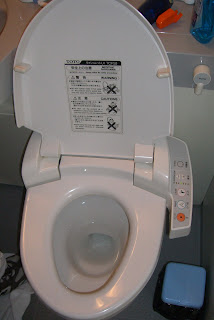5. Only in Japan...will boybands like this hit the number one spot in the rankings:

4. Only in Japan...can you find "live" billboards on a truck:

As I was walking down Harajuku, I saw a crowed over by the street flashing their cameras that what I though was just a billboard vechicle, just like the ones that circulate the MSU campus. But upon further investigation, found out that the people on the billboard moved! Stupid me I thought they were just mannequins, damn good looking mannequins too. It took me 5 seconds to find out that they were actual people. A great way to advertise I guess. (they were advertising for a CD release of some band).

Dr. Ross was cool enough to have hooked us up with a plant tour of the world renowned soy producer, Kikkoman (I was actually interested in this plant tour...I consumer Kikkoman's soysauce like others do with milk). Anyways, after the tour ended, the company treated us with icecream. Soysauce flavored icecream. Thats a first for me. Reluctant at first, I gave it a little lick like a cautious dog. It didnt taste bad at all! Hell, it tasted better than those air-pumped icecream back in Thailand. Not salty like you may all think at all!
2. Only in Japan...can you buy your child a condom suit for Halloween:

There are lots of strange foods in Japan, but there are also plenty of weird 'things' too. Like this purple condom custome I can across to in Shibuya. Woudn't it be the perfect Halloween costume for your 10 year olds? Just imagine them trick-or-treating in their FULL BODY purple condom outfit. Only 28 bucks folks, for a definate banned item in the US.
1. Only in Japan...will you be able to cross an intersection diagonally with hundreds of other pedestrians:

This is truly unique to the famous Shibuya crossing in Tokyo, Japan. Shibuya is Tokyo's version of Broadway + Fifth Avenue, but bigger. Thousands of people walk in this district that is filled with department stores, resturants, and brand name stores. At the center of it all, just right in from of the Shibuya train station, is the crossing. Hundreds of people gather at the edge of the streets waiting for that 'walk' signal to light up. When the cars stop and the light signals go, mobs of people flock from all directions filling tp the entire road. When viewed from a high buidling, it seems like there is no road.
But thats not it....
BEYOND NUMBER 1... THE ULTIMATE...
Only in Japan...will you feel violated after taking a dump:

Everyone would agree that Japan is one of the most, if not the most technologically advanced nation in the world. They're so advanced that technology extends onto your toilet seat. Lets start off with something that's easy to comprehend - the seat is heated. Alright! that'll be nice for the winter. Next, there's an automatic flush function. Great! I dont have to push a button for pull the lever. Thats just the basic; they had that for decades. Here comes the fun part. The toilet offers to clean your butt for you. At a push of a button, a plastic arm will extend from one side of the bowl and shoot water straight to where the mess was made. But thats not it. You can adjust the water pressure AND the water shooting? (i guess...) between bidet or spray. I had to try it once. Very unique experience if you ask me. Never felt this violated before in my life. Thanks toilet, I can wipe my own butt ^^'





 Along the sides of the main temple are rows of small statues with bonnets and windmills. These statues are the protector of the souls of stillborn children, or jizobosatusu in Japanese. Mothers who have lost an unborn child often dedicate such statues and decorate it with toys and clothing
Along the sides of the main temple are rows of small statues with bonnets and windmills. These statues are the protector of the souls of stillborn children, or jizobosatusu in Japanese. Mothers who have lost an unborn child often dedicate such statues and decorate it with toys and clothing 
























 ไม่ได้ทำเองนะ! ซื้อมา ¥450 จากร้านสะดวกซื้อข้างที่พัก Omusoba ก็คือไข่เจียวโปะผัด yakisoba ราดซอสมะเขือกับเมโยนั่นเอง มื้อนี้เป็นมื้อเงียบๆนั่งกินคนเดียวในห้องเพราะเด็ก msu คืนแรกแม่งก็ปาร์ตี้กันแล้ว (หิหิ เราก็แอบไปประเดิมช็อดสาเกกะเขาก่อนกลับห้องตนเองเหมือนกัน) Omusoba อร่อยมาก คงเป็นเพราะบนเครื่องบินอดอยากมา อยากทำเป็นจัง ต้องหัดละ ส่วนเบียร์ก็ dry สมชื่อ (มันเขียนไว้ว่า “super dry” บนกระป๋อง) ขมดีเหมือนเบียร์ไทยเลย หมายเหตุ: ที่ญี่ปุ่น20 ก็ซื้อและดื่มสุราได้
ไม่ได้ทำเองนะ! ซื้อมา ¥450 จากร้านสะดวกซื้อข้างที่พัก Omusoba ก็คือไข่เจียวโปะผัด yakisoba ราดซอสมะเขือกับเมโยนั่นเอง มื้อนี้เป็นมื้อเงียบๆนั่งกินคนเดียวในห้องเพราะเด็ก msu คืนแรกแม่งก็ปาร์ตี้กันแล้ว (หิหิ เราก็แอบไปประเดิมช็อดสาเกกะเขาก่อนกลับห้องตนเองเหมือนกัน) Omusoba อร่อยมาก คงเป็นเพราะบนเครื่องบินอดอยากมา อยากทำเป็นจัง ต้องหัดละ ส่วนเบียร์ก็ dry สมชื่อ (มันเขียนไว้ว่า “super dry” บนกระป๋อง) ขมดีเหมือนเบียร์ไทยเลย หมายเหตุ: ที่ญี่ปุ่น20 ก็ซื้อและดื่มสุราได้
